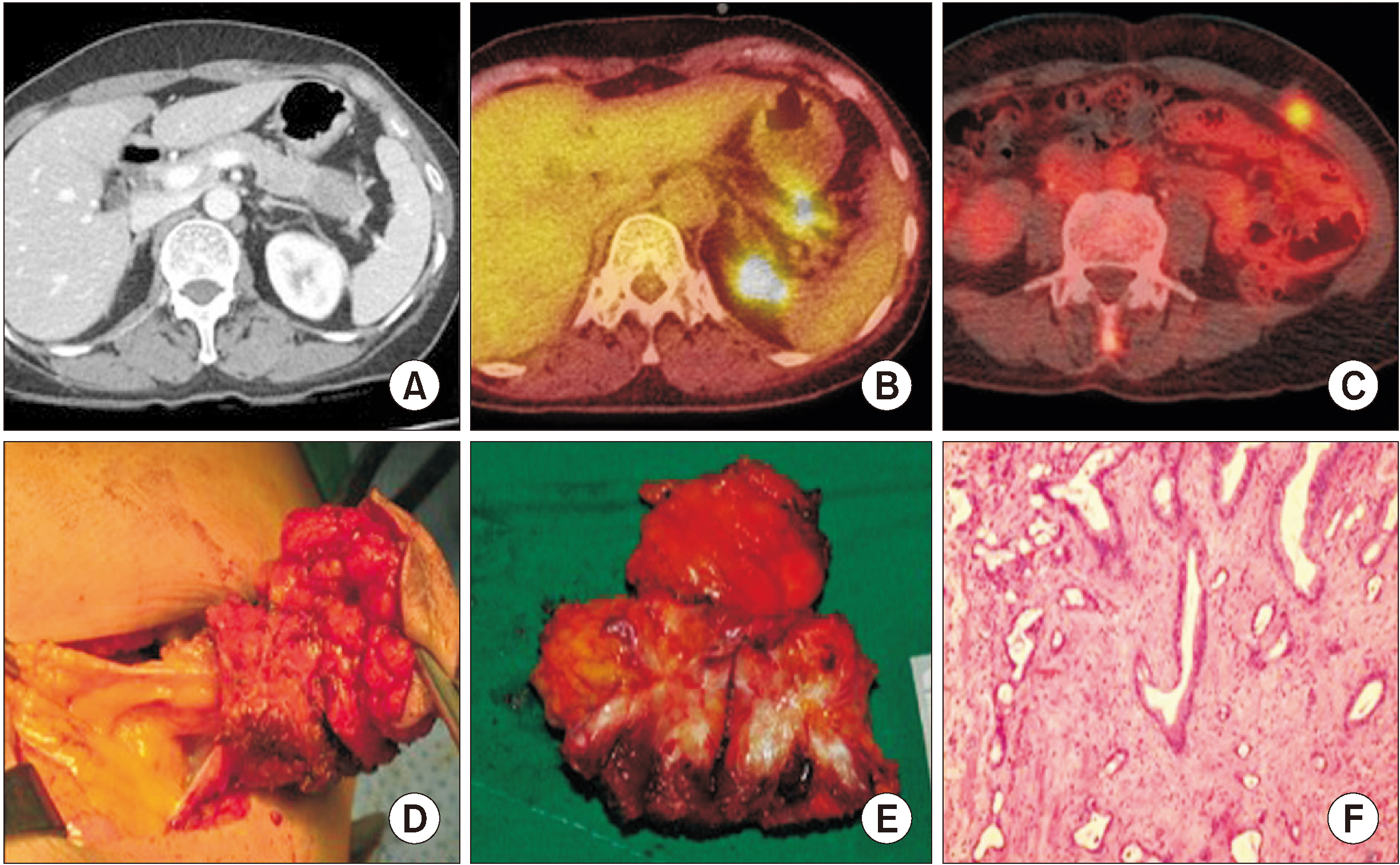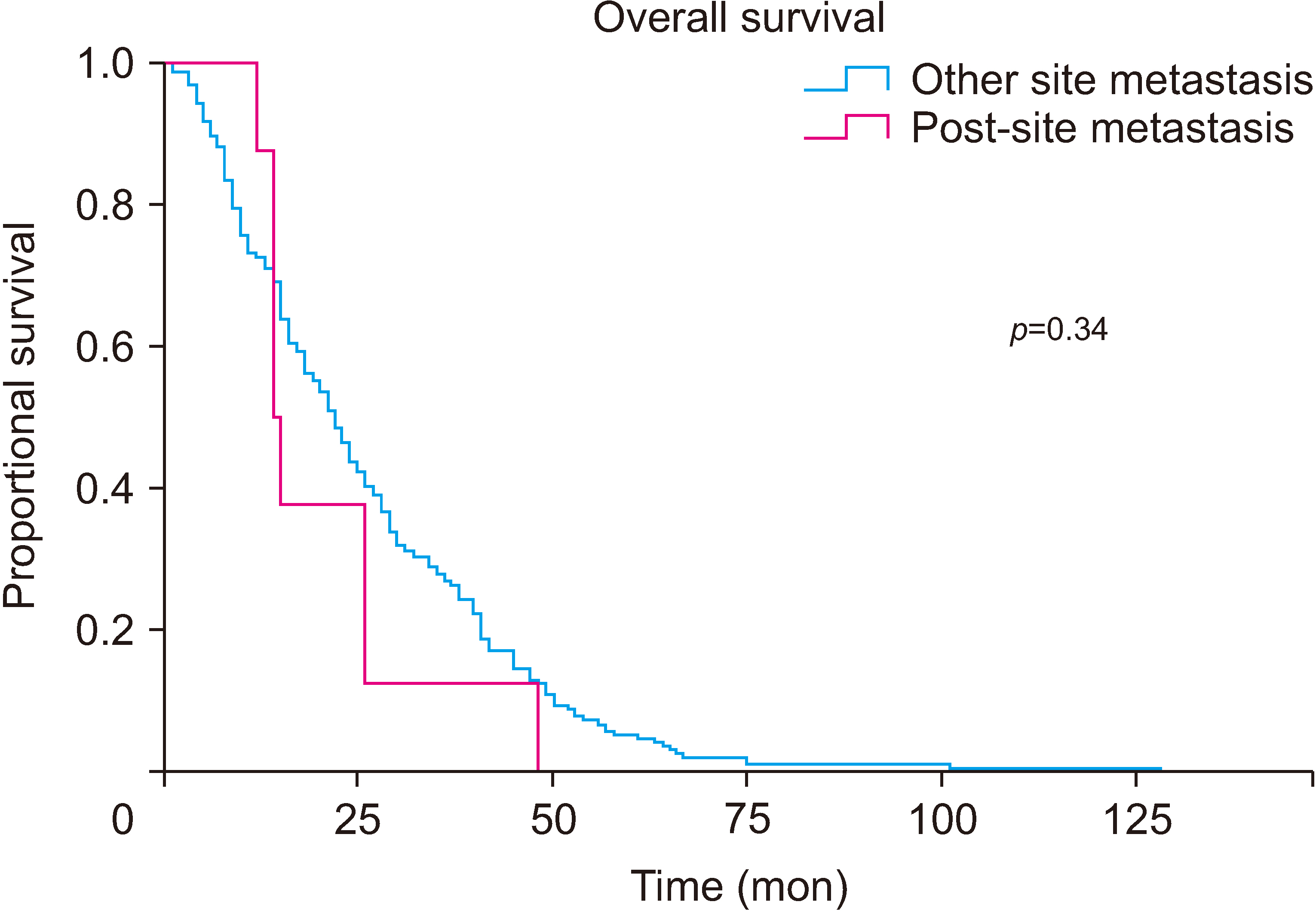Ann Hepatobiliary Pancreat Surg.
2024 Feb;28(1):104-108. 10.14701/ahbps.23-092.
Port-site metastasis after laparoscopic radical pancreatosplenectomy in left-sided pancreatic cancer
- Affiliations
-
- 1Division of Hepatobiliary and Pancreatic Surgery, Department of Surgery, Yonsei University College of Medicine, Seoul, Korea
- 2Pancreaticobiliary Cancer Clinic, Yonsei Cancer Center, Severance Hospital, Seoul, Korea
- 3Division of Multidisciplinary Surgery, Tau Sunkar, Almaty, Kazakhstan
- KMID: 2553372
- DOI: http://doi.org/10.14701/ahbps.23-092
Abstract
- Despite debates regarding the safety of well-selected left-sided pancreatic cancer, minimally invasive distal pancreatosplenectomy is considered safer and more effective than open distal pancreatosplenectomy in well-selected patients. Previous studies have shown that minimally invasive surgery yields comparable oncologic outcomes to open surgery. While patients who undergo minimally invasive distal pancreatosplenectomy also experience recurrences and metastases after surgery, port-site metastasis is particularly rare. In this report, we report an extremely rare case of port-site metastasis following minimally invasive distal pancreatosplenectomy for left-sided pancreatic cancer.
Figure
Reference
-
1. Ducreux M, Cuhna AS, Caramella C, Hollebecque A, Burtin P, Goéré D, et al. 2015; Cancer of the pancreas: ESMO Clinical Practice Guidelines for diagnosis, treatment and follow-up. Ann Oncol. 26 Suppl 5:v56–68. DOI: 10.1093/annonc/mdv295. PMID: 26314780.
Article2. Aida T, Iwase R, Usuba T, Kumagai Y, Furukawa K, Onda S, et al. 2023; Successful resection of port site recurrence of pancreatic ductal adenocarcinoma after laparoscopic distal pancreatectomy. Surg Case Rep. 9:35. DOI: 10.1186/s40792-023-01607-w. PMID: 36867254. PMCID: PMC9984651.
Article3. Lee SH, Kang CM, Hwang HK, Choi SH, Lee WJ, Chi HS. 2014; Minimally invasive RAMPS in well-selected left-sided pancreatic cancer within Yonsei criteria: long-term (>median 3 years) oncologic outcomes. Surg Endosc. 28:2848–2855. DOI: 10.1007/s00464-014-3537-3. PMID: 24853839.
Article4. Choi SH, Kang CM, Hwang HK, Lee WJ, Chi HS. 2012; Robotic anterior RAMPS in well-selected left-sided pancreatic cancer. J Gastrointest Surg. 16:868–869. DOI: 10.1007/s11605-012-1825-6. PMID: 22258879.
Article5. Choi SH, Kang CM, Lee WJ, Chi HS. 2011; Laparoscopic modified anterior RAMPS in well-selected left-sided pancreatic cancer: technical feasibility and interim results. Surg Endosc. 25:2360–2361. DOI: 10.1007/s00464-010-1556-2. PMID: 21298529.
Article6. Kang CM, Kim DH, Lee WJ. 2010; Ten years of experience with resection of left-sided pancreatic ductal adenocarcinoma: evolution and initial experience to a laparoscopic approach. Surg Endosc. 24:1533–1541. DOI: 10.1007/s00464-009-0806-7. PMID: 20054579.
Article7. Kang CM, Lee SH, Lee WJ. 2014; Minimally invasive radical pancreatectomy for left-sided pancreatic cancer: current status and future perspectives. World J Gastroenterol. 20:2343–2351. DOI: 10.3748/wjg.v20.i9.2343. PMID: 24605031. PMCID: PMC3942837.
Article8. Hong SS, Hwang HK, Lee WJ, Kang CM. 2020; Feasibility and safety of laparoscopic radical distal pancreatosplenectomy with adrenalectomy in advanced pancreatic cancer. Ann Surg Oncol. 27:5235–5236. DOI: 10.1245/s10434-020-08670-9. PMID: 32474822.
Article9. Kim SJ, Park JY, Hwang HS, Kang CM. 2021; Complete response of locally advanced left-sided pancreatic cancer after modified FOLFIRINOX chemotherapy followed by conversion surgery: a case report. Ann Hepatobiliary Pancreat Surg. 25:390–394. DOI: 10.14701/ahbps.2021.25.3.390. PMID: 34402441. PMCID: PMC8382870.
Article10. Kim YS, Kim JS, Kim SH, Hwang HK, Lee WJ, Kang CM. 2022; Laparoscopic radical distal pancreatosplenectomy with celiac axis excision following neoadjuvant chemotherapy for locally advanced pancreatic cancer. Ann Hepatobiliary Pancreat Surg. 26:118–123. DOI: 10.14701/ahbps.21-097. PMID: 34907094. PMCID: PMC8901982.
Article11. Bărbulescu M, Alecu L, Boeţi P, Popescu I. 2012; Port-site metastasis after laparoscopic surgery for colorectal cancer--still a real concern? Case report and review of the literature. Chirurgia (Bucur). 107:103–107.12. Lupinacci RM, Santana A, Dias AR. 2014; Metastatic gallbladder adenosquamous carcinoma to the skin. J Surg Case Rep. 2014:rju130. DOI: 10.1093/jscr/rju130. PMID: 25480835. PMCID: PMC4256706.
Article13. Berger-Richardson D, Chesney TR, Englesakis M, Govindarajan A, Cleary SP, Swallow CJ. 2017; Trends in port-site metastasis after laparoscopic resection of incidental gallbladder cancer: a systematic review. Surgery. 161:618–627. DOI: 10.1016/j.surg.2016.08.007. PMID: 27743715.
Article14. Maker AV, Butte JM, Oxenberg J, Kuk D, Gonen M, Fong Y, et al. 2012; Is port site resection necessary in the surgical management of gallbladder cancer? Ann Surg Oncol. 19:409–417. DOI: 10.1245/s10434-011-1850-9. PMID: 21698501.
Article15. Gao KJ, Yan ZL, Yu Y, Guo LQ, Hang C, Yang JB, et al. 2020; Port-site metastasis of unsuspected gallbladder carcinoma with ossification after laparoscopic cholecystectomy: a case report. World J Clin Cases. 8:5729–5736. DOI: 10.12998/wjcc.v8.i22.5729. PMID: 33344567. PMCID: PMC7716338.
Article16. Petryshyn N, Dražić T, Hogendorf P, Strzelczyk J, Strzałka A, Szwedziak K, et al. 2021; Port site metastases a year after initial laparoscopic cholecystectomy. Should the use of retrieval bags during laparoscopic cholecystectomy be the new gold standard? Pol Przegl Chir. 93:61–65.17. Zhou HY, Wang XB, Gao F, Bu B, Zhang S, Wang Z. 2014; Cutaneous metastasis from pancreatic cancer: a case report and systematic review of the literature. Oncol Lett. 8:2654–2660. DOI: 10.3892/ol.2014.2610. PMID: 25364444. PMCID: PMC4214468.
Article18. Chong A, Venugopal K, Segarajasingam D, Lisewski D. 2011; Tumor seeding after EUS-guided FNA of pancreatic tail neoplasia. Gastrointest Endosc. 74:933–935. DOI: 10.1016/j.gie.2010.10.020. PMID: 21951481.
Article19. Kang CM, Hwang HK, Park J, Kim C, Cho SK, Yun M, et al. 2016; Maximum standard uptake value as a clinical biomarker for detecting loss of SMAD4 expression and early systemic tumor recurrence in resected left-sided pancreatic cancer. Medicine (Baltimore). 95:e3452. DOI: 10.1097/MD.0000000000003452. PMID: 27124039. PMCID: PMC4998702.
Article20. Rajeshkumar NV, Yabuuchi S, Pai SG, Tong Z, Hou S, Bateman S, et al. 2016; Superior therapeutic efficacy of nab-paclitaxel over cremophor-based paclitaxel in locally advanced and metastatic models of human pancreatic cancer. Br J Cancer. 115:442–453. DOI: 10.1038/bjc.2016.215. PMID: 27441498. PMCID: PMC4985357.
Article
- Full Text Links
- Actions
-
Cited
- CITED
-
- Close
- Share
- Similar articles
-
- Laparoscopic distal pancreatosplenectomy for left-sided pancreatic cancer in patients with radical subtotal gastrectomy for gastric cancer
- Incidentally Found Port Site Metastasis followings Laparoscopic Radical Nephrectomy for a Renal Cell Carcinoma
- A Five-Year Survivor without Recurrence Following Robotic Anterior Radical Antegrade Modular Pancreatosplenectomy for a Well-Selected Left-Sided Pancreatic Cancer
- Port-site Metastasis Following Laparoscopic Cholecystectomy
- Minimally invasive radical antegrade modular pancreatosplenectomy: routine vs. modified



